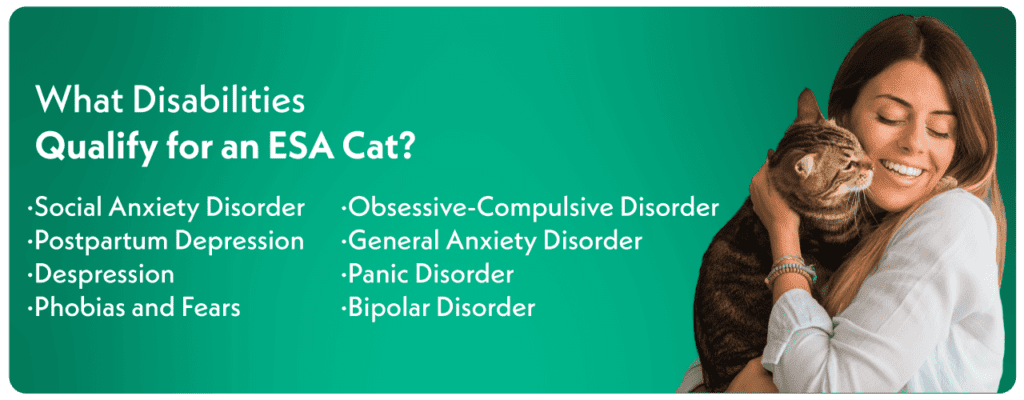Everything You Need to Know About Emotional Support Cats

When it comes to emotional support animals (ESAs), most people immediately think of dogs. But an emotional support pet can be any animal or breed that comforts someone with anxiety, depression, or other mental health issues. This means that cats can be emotional support animals, too.
Emotional support cats can provide a variety of benefits for their owners’ mental and emotional health. For example, several studies have shown that cats can lower stress and blood pressure levels. ESAs can also help decrease loneliness and benefit individuals with post-traumatic stress disorder (PTSD).
This article discusses the many advantages of having cats as emotional support animals and how to get an emotional support cat.
What Is an Emotional Support Cat (ESC)?
An emotional support cat provides companionship, comfort, and emotional assistance to their owner. While an ESA can technically be any type of animal — such as a rabbit or miniature horse — the most common types of emotional support animals are cats and dogs.
Emotional support cats can help reduce some of the negative symptoms concerning the handler’s psychological or emotional disabilities. For example, people who suffer from anxiety or depression may find that a cat’s companionship relieves feelings of sadness, stress, and loneliness. They achieve this by calming down their owners and reducing their emotional stress.

Is an Emotional Support Cat Different from Therapy Cats and Service Animals?
While they might all sound like the same thing, it’s important to understand the key differences between an emotional support cat, a therapy cat, and a service animal. This will help you determine which assistance animal will best serve your needs.
From helping with daily activities to relieving depression and anxiety, each support animal has its own benefits. Furthermore, all of them offer different protections concerning housing, travel, and more, which can be useful if you are planning to take your support animal places with you.
Emotional Support Cats
Emotional support cats are known for improving a person’s mental health and well-being. They don’t have to be trained since therapy is already part of their nature. They relieve anxiety, depression, and stress-induced pain among people with certain medical conditions.
Emotional support animals, including support cats, are included in the Fair Housing Act, which offers certain protections from the US Department of Housing and Urban Development. This means you can live with your emotional support cat regardless of a property’s pet policies.
However, you should register your cat as an emotional support animal to benefit from the Fair Housing Act. Unfortunately, since 2020, these protections don’t apply to airlines, and you’ll have to pay the airline’s pet fee and use a pet carrier.
Therapy Cats
Therapy cats are very different from emotional support cats and service animals, with the main distinction being training and who the cat is intended to benefit. A therapy cat is trained to work in a therapy environment to provide skills such as support and comfort.
Several organizations offer therapy cat training, such as Pet Partners, Wags for Hope, Love on a Leash, and many other programs. Therapy cats have to pass specific tests that check if they can offer comfort in public spaces such as rehab centers, nursing homes, and schools.
Unfortunately, therapy cats don’t have special rights like service animals or emotional support cats. You have to get permission before taking the cat to restaurants, apartments, workplaces, or other private spaces.
Service Animals
Service animals are specifically trained to assist people with disabilities in performing daily duties. They are also allowed to follow their owners in areas where they typically don’t allow pets, such as hospitals, grocery stores, and more.
While dogs are the only animals classified as service animals, some cats can alert you in case of a medical emergency. However, assisting with daily duties is often difficult for cats to learn. Due to this, cats can’t be recognized or registered as service animals, but they are excellent emotional support animals.
Even if people with disabilities are better off working with a service animal, those looking for emotional relief can benefit from either a therapy cat or an emotional support cat. However, you will not enjoy the protections under a registered service animal like a dog.
Benefits of Having a Support Cat for Companionship

If you have a mental illness, like anxiety or depression, emotional support animals can be extremely beneficial. If your condition is more severe, you may consider getting a psychiatric service dog instead. The specific advantages provided by emotional support cats will vary from person to person, but some common benefits are:
They Offer Emotional Support
Having a support cat offers more than companionship; it can also help improve our emotional well-being and mental health. Studies show that cats can increase dopamine levels in your body. The neurochemical is often associated with bonding: love, pleasure, or general happiness. Taking care of your cat also helps you feel less depressed and lonely since it’s always around.
Emotional Support Cat Eases Travel Anxiety
If you have a phobia of traveling, especially on flights, having a cat as you travel can greatly lower your anxiety levels. Having something to hold or hug during travel allows you to focus on anything other than yourself and shift your attention from overthinking things that lead to anxiety. Additionally, having something that depends on you during your travels prevents excessive rumination.
Unfortunately, all ESA animals, regardless of size, are treated the same as ordinary pets by airlines as per the Air Carrier Access Act update. This means an ESA certification won’t be enough to have your cat travel on your lap like a service animal would. You can, however, make a pet reservation when booking your flight. It’s best to check the cat carrier’s weight and size restrictions to ensure your preferred carrier aligns with the airlines’ regulations.
Avoid Pet Deposits and Fees
While they don’t fall under service animals, cats can be registered as emotional support animals, which are protected under the Fair Housing Act. This means you will avoid paying hefty pet deposits and fees if you have an official letter showing the cat is an emotional support animal.
How to Qualify for an Emotional Support Cat
To qualify for an emotional support animal, including a support cat, you must get an ESA letter from a mental health professional.
ESA Pet is a reliable emotional support animal letter service that can connect you with a qualified mental health professional licensed in your state. Simply follow these three easy steps to get your ESA letter.
Step 1: Pre-Screening Questionnaire
This quiz will ask some basic questions about your cat and mental health. It will only take two minutes to complete. Your responses will help us determine whether you are an eligible candidate for an emotional support cat.
Step 2: Speak With a Licensed Mental Health Professional
After completing the pre-screening questionnaire, ESA Pet will connect you with a mental health professional licensed in your state. You will have a brief phone consultation to discuss your mental health.
Step 3: Get Your ESA Letter
Upon approval, ESA Pet will promptly send you the ESA letter within 24 hours after the consultation.
The entire process is simple, easy, and quick. Get started with ESA Pet today.
Get your Official ESA Letter Consultation from a licensed therapist.
Get ESA Letter Now
How to Register an Emotional Support Cat
You do not need to register your cat as an emotional support animal with any database or organization. Also, support cats are not required to wear special tags or vests.
The only proof you need is an ESA letter from a licensed mental health professional. You can provide it to your landlord as evidence that your cat is an emotional support animal. Your emotional support cat will then be afforded protections under the Fair Housing Act.
Emotional Support Cat Eligibility
As a cat owner, you must visit a licensed mental health practitioner who will evaluate and recommend an ESA if you are eligible. The eligibility criteria for getting an emotional support animal letter is having a diagnosed mental health condition such as depression, ADHD, anxiety, or PTSD that limits your day-to-day activities.
Suppose the mental health professional determines an emotional support cat will relieve your mental health condition. In that case, they will provide a signed ESA letter that contains their contact information and license number.
Beware of Scammers
There is no formal process for registering or certifying a cat; all the owner requires is an ESA letter to qualify their cat as an emotional support animal. There is no service known as ESA cat registration. If you come across such a service or a website promoting the same, they are running a scam. However, there are programs for training your cat to become a therapy cat in public environments.
Housing Rights of an Emotional Support Cat
All housing providers, including landlords for rental buildings, temporary houses, etc., must allow residents to keep their emotional support animals. This is considered a reasonable accommodation for a disability unless the emotional support animal is dangerous or unsafe to others.
Landlords with no-pet policies, or policies that restrict certain breeds, weights, or sizes of pets, must make an exception for emotional support animals.
If an emotional support animal causes damage or disruption, the owner is responsible for covering any resulting costs.
Flying With Your Emotional Support Cat
According to the latest guidance by the Department of Transportation, airlines are no longer required to accommodate travelers with emotional support animals, including support cats. American, Delta, United, JetBlue, Spirit, and Frontier are some of the major airline carriers that no longer allow emotional support animals.
If you are unable to travel with your support animal, it may lead to distress and other emotional issues. Luckily, your cat can still fly in the cabin with you. The only difference is that you are no longer exempt from paying pet fees, and the cat must be placed in a carrier.
Some international and domestic airlines allow emotional support animals on board for free. Therefore, if you want to travel with your support cat, you only have to book these disability-friendly airlines. Just be sure to check out the airline’s requirements for ESAs before traveling. You will most likely need to submit certain documents, like your ESA letter and a relief attestation form.
Best Breeds For Emotional Support Cats
Just as there are ideal breeds for emotional support dogs, like Golden Retrievers and Labradors, there are also ideal breeds for support cats.
If you have a mental or emotional disability and wish to include an emotional support cat in your treatment plan, consider these breeds:
American Shorthair

The American Shorthair is a family favorite and ideal for an emotional support cat. They have even temperaments and above-average intelligence levels. This breed is very gentle-natured and good around kids and other animals. American Shorthairs make excellent emotional support cats.
Maine Coon

Maine Coon cats also make great feline companions and emotional support cats. They are active, easy to train, and extremely intelligent. They are also known for developing deep relationships with their owners, which is ideal for emotional support cats.
American Bobtail

The American Bobtail is a relatively new breed but is already a fan favorite for emotional support cats, therapy cats, and family pets. They are affectionate, active, less vocal, and very independent. Additionally, American Bobtail cats have tails almost half the size of other cat breeds. They make wonderful companions for anyone in need of comfort and support.
Russian Blue

The Russian Blue cat breed is intelligent, easy to love, and extremely quiet. While they are less demanding than other felines, Russian Blues are very affectionate toward their owners. These are classic family cats, as well as ideal emotional support cats.
Persians

Persians are one of the more visually appealing breeds. They have lush coats (that require significant grooming) and unique faces. Persian cats are very gentle and quiet, making them an excellent breed for those suffering from anxiety, extreme stress, or PTSD.
Manx

Manx are commonly known for not having tails. Beyond that, the Manx cat breed is intelligent, playful, and quite gentle. They love interacting with their owners and tend to attach themselves to a single family member. With a loyal and endearing nature, the Manx breed makes for the perfect support cat.
Bengal

The Bengal breed is active and independent. But they are also intelligent and athletic. Bengals are not as cuddly as other breeds but still require some attention every now and then. Most enjoy being outside, and some will even go for walks on a leash with their owners!
Frequently Asked Questions
How Is an Emotional Support Animal Different From a Service Animal?
Emotional support animals (ESA) provide therapeutic benefits through companionship and affection. They do not require any special training and do not perform specific tasks. ESAs can help with anxiety, depression, bipolar disorder, post-traumatic stress disorder (PTSD), and more.
On the other hand, service animals are specially trained to perform tasks that help someone with a disability. People who require a service animal typically need assistance because of an illness like asthma, diabetes, epilepsy, etc.
Further, emotional support animals are not limited to dogs. They come in different animal types and breeds, such as cats, dogs, birds, hedgehogs, and occasionally miniature horses. Service animals are strictly dogs.
How Do I Know If My Cat Is an Emotional Support Animal?
Determining if your cat is an emotional support animal depends on how you feel when you are with your cat. The cat could make an excellent emotional support animal if you become more relaxed. However, you still need an ESA letter for your cat to qualify.
Are Cats Emotionally Attached to Humans?
Yes, cats can form an emotional bond with humans. While they might not be as outwardly affectionate as dogs, they can provide just as much comfort and support. Cats can show affection, seek comfort from their owners, and demonstrate behaviors that indicate emotional attachment, such as purring, kneading, and rubbing against their owners.
Are Male or Female Cats Better for Emotional Support?
No definitive answer exists as to whether male or female cats are better for emotional support. However, some believe that male cats may be better for people who need a more active and playful companion, while female cats may be better for those who need a calmer and more affectionate companion.
Are Cats Better Than Dogs for Emotional Support?
There is no one-size-fits-all answer since the best ESA type for you depends on your individual needs and preferences. However, there are advantages of having a cat as an ESA. They are smaller and less demanding than dogs, making them easier to care for and transport. They are also more independent.
Do I Need Special Training for My Emotional Support Cat?
No special training is required for emotional support cats. Only service animals must be individually trained to do work and perform tasks that help their owner’s disability.
Which Conditions Does an Emotional Support Cat Help?
Having a pet, such as a cat, may help to reduce stress, anxiety, and depression. Also, they may help to reduce loneliness and encourage playfulness.
What Is an ESA Letter?
An emotional support animal letter is written for an animal companion deemed to provide mental and emotional benefits for the owner. ESA letters can be used for housing and travel purposes, proving that the animal provides key therapeutic benefits.
How Do I Find a Doctor Who Will Prescribe an ESA Letter?
If you’re eligible, ESA Pet can easily schedule an assessment with a doctor or other qualified mental health professional who can issue an ESA letter. To schedule an appointment with a mental health professional for an ESA letter evaluation, simply visit the ESA Pet website.
Conclusion: Getting Your Emotional Support Cat
Any animal that provides therapeutic value can be considered an emotional support animal, including cats. A qualified emotional support cat requires a letter prescribed by a licensed mental health professional stating that the animal provides emotional support and comfort to its owner.
Individuals suffering from psychological disabilities, mental disabilities, mental illness, and emotional disabilities may meet the requirements for an emotional support animal with ESA Pet. Simply put, if you’re a cat owner, several emotional conditions will qualify.




